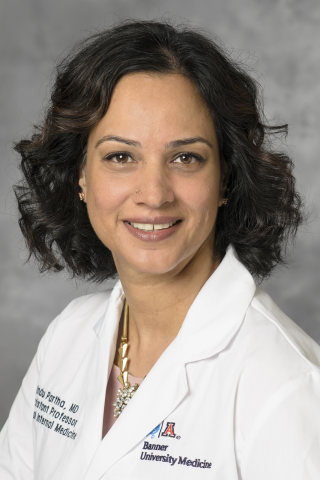As health professions educators, teachers, family, friends and as humans… we are still reflecting on 2020 and working towards a better 2021 and beyond. Many of us find comfort in academic medicine with a predictability of caring for patients, teaching trainees, and promoting self-learning. But how many of us expected to navigate a full-blown pandemic? Raise your hand if you graduated from your training feeling “if there is a pandemic, I am ready!”
This feeling of uncertainty affected the two of us as medical educators uniquely. Like everyone, we were concerned for the health of our loved ones and ourselves. At home, we were juggling working from home with children’s virtual classrooms and personal responsibilities. At work, we tried to keep the education routine for our healthcare trainees – preparing for the graduation of senior residents, orienting the incoming interns, and maintaining education conferences. But it was not routine – conducting teaching virtually, changing curricula to adjust for social distancing and missing out on human interaction. Internally we were struggling to reach an equilibrium. How could we balance the demands of the novel coronavirus, which was changing our spheres of control, and still keep our sense of normalcy?
We present the views of two Internal Medicine physicians with different roles as clinician educators trying to navigate these challenges.
Perspective of a Primary Care Physician
What is normal to me is constancy. Schedule. I like to know what I am doing and when I am doing it. My phone calendar is kept up to date and I refresh my electronic health record multiple times per clinic day so that I know which patient has been checked in and is ready to be seen. I like predictability. I like to feel I am making a difference. The COVID-19 pandemic turned my life upside down. Like many in healthcare, my daily life now is a far cry from what it was at the start of 2020. I am supposed to be one of those “healthcare heroes,” but let me tell you a secret: I do not feel like one. As a primary care provider, I know that I am “on the frontline,” but I am not intubating the critically ill, triaging patients in the emergency department, or worrying about soiled PPE. My place in the work stratosphere has been upended, and without this stability, I feel unmoored. I feel guilty that I am not at the same risk for harm as my inpatient colleagues and wonder if I am really part of “the healthcare army” when I am conducting a telehealth visit counseling a 59 year old man about how to take control of his blood sugars. If I am not face to face with my patient in the exam room, comforting the sick, reviewing lab values, or diagnosing the cause of symptoms am I still a valuable member of the healthcare team? The pandemic has made me realize how much I relied on routine and tradition to give my work life structure, form, and dare I say, meaning, in the past. As the months roll on, I am slowly realizing that we each have our own role to play as we work tirelessly to keep patients cared for and our health systems afloat. Some physicians are visible and “front facing,” some are in harm’s way daily and receive no fanfare, while others are diligently providing the chronic disease care that is always needed, pandemic or not.
Perspective of a Critical Care Physician
There is a comfort in having some predictability in work. Even with the craziest days, my sense of order as an academic medical intensivist comes from a set call schedule, work with a team of nurses, respiratory therapists, residents and fellows known to me, and clinical and medical education research projects that are a welcome academic diversion from clinical work. There is a dopamine surge that comes with checking off tasks on a “to do” list, marking satisfaction with the organization and accomplishments. Even the approach to the unpredictable clinical deterioration of a patient can be reframed into a systematic rubric (e.g., Circulation-Airway-Breathing) to find order and clarity.
Maybe this is why the last year has been so unnerving for me. My framework of predictability was lost. I was in the position to care for these critically ill patients as a frontline worker and yet I did not have the comfort of science and evidence-based medicine to guide what I know to do best. Aspects of work I found most enjoyable – clinical teaching and research – took a backseat to focus on planning and preparing for the inevitable surge of patients. All of our efforts in the spring shifted from the usual work tasks to one common goal – preparing for and navigating the COVID-19 pandemic. But how do you plan for something you do not know much about? There was data overload, with a myriad of publications and yet minimal, if any, high quality evidence-based recommendations. I connect to structure and order, and in my COVID-19 experience so far, there was neither.
Our Conclusion
Primary care physicians and critical care physicians have both been forced to adapt to the pandemic and new demands. Our experiences seem like polar opposites, one struggling to keep patients out of the hospital and another struggling to get them back home. We share a pandemic, but do not share a pandemic experience. However, as medical educators, we do share the academic experience. And that has been a constant, though not necessarily a predictable one in the last year. There continues to be learners to guide, lectures to give, students to mentor, and yes, promotion hoops to jump through. Even as COVID-19 surged, new interns joined the family, and our educational mission continued. The cyclical nature of academic medicine is comforting in its repetition and unchanging quality.
Did you know that the Harvard Macy Institute Community Blog has had more than 265 posts? Previous blog posts have explored topics including designing programmatic assessment structures to support learning, engaging students virtually, and being together, when apart.
Author BIO's

Vidya Krishnan, MD MHS (Educators ’20) is a medical educator and pulmonary, critical care, and sleep physician. Vidya currently holds a position as Director of Scholarship for the Case Western Reserve University / MetroHealth campus Internal Medicine residency program. Vidya’s areas of professional interest include improving scholarship opportunities for medical trainees, creating simulations to coach trainees how to teach procedural skills, and clinical research studying the intersection of sleep disorders and chronic medical conditions. Vidya can be followed on Twitter, LinkedIn, or contacted via email.

Indu S. Partha, MD FACP MHS (Educators ’20) is a medical educator and general internist. Indu currently holds a position as Associate Program Director for the University of Arizona Internal Medicine Residency Program at South Campus. Indu’s areas of professional interest include improving ambulatory education in GME, raising the profile of primary care medicine, and promoting diversity and equity in medicine. Indu can be followed on Twitter, LinkedIn, or contacted via email.
HMI Staff


